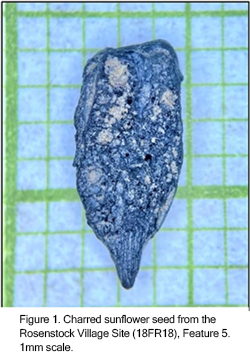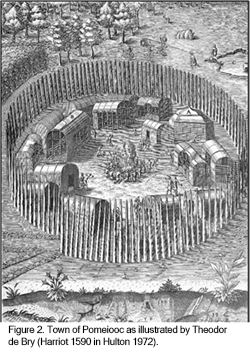Curator's Choice 2021
“Sunflowers”
July 2021 By: Alex Glass, Archaeologist
With their large sunny faces and towering stature, sunflowers (Helianthus annuus) are one of the most well-loved and well-known members of the Asteraceae family. The bright yellow fringe around the center of the sunflower, often to referred to as petals, are bracts, cleverly colored to entice bees and other pollinators. In the center are hundreds of tiny flowers which, when pollinated, become sunflower seeds. Sunflower seeds are also called achenes and are composed of a hard outer shell surrounding the softer seed inside. The outer shell (or pericarp) is tough and generally considered inedible, but the seed which it holds is high in beneficial fats and protein as well as essential minerals.

The small, carbonized sunflower seed pictured to the right was recovered from a large pit feature at the Rosenstock Village Site (18FR18), a Late Woodland period (950-1600 AD) precontact site in Frederick County, Maryland. Radiocarbon dating of other charcoal within the feature suggests the sunflower seed dates to the 12th century (Curry and Kavanaugh 2004: 24). In addition to the sunflower seed, over 100 other seed and nut fragments were identified, including maize (Zea mays), Sumac (Rhus sp.), blackberry or raspberry (Rubus sp.), and many grasses and small-seeded weedy plants. The presence of these species tells archaeologists that the residents of Rosenstock Village lived in an open environment where plants requiring full sun could thrive, but also that nearby forested areas provided the opportunity to forage nuts and fruits to supplement agriculturally sourced foods. Many of these species also ripen in the late summer to autumn and may suggest the pit was filled with refuse during these periods of the year. Both archaeological and genetic studies have confirmed that sunflowers were domesticated between 5,000 and 3,800 years ago in central North America, well before maize agriculture became dominant, and are one of a group of crops archaeologists refer to as the Eastern Agricultural Complex (Smith 2014: 57).
Records written by Europeans describe sunflowers growing interspersed with maize (Heiser 1951) while

other accounts depict sunflowers growing near the village periphery (Hulton 1972). Aside from the aesthetic and nutritional value, it is not surprising sunflowers became a standard component in indigenous agriculture and gardens. In recent decades sunflowers have increasingly been recognized for the beneficial roles they can play in commercial agriculture. Sunflowers have a deep taproot which can help improve soil by encouraging the development of beneficial bacteria, fungi, and microbes (Vollmer-Sanders 2018). Sunflowers also provide a habitat in which beneficial predatory insects and pollinators can flourish, resulting in increased crop yield and decreasing the damaging effects of other pests.
Although small, the sunflower and other plant remains provide
an importance source of data for understanding how the occupants of Rosenstock lived.
Aside from being a pretty garden plant, sunflowers
fulfilled multiple functions within indigenous agriculture and people benefited,
and continue to benefit, in multiple ways from their cultivation.
References
Curry, Dennis and Maureen Kavanaugh
2004. Excavations at the Rosenstock Village Site
(18FR18), Frederick County, Maryland: A Preliminary Report. Maryland
Archaeology Vol. 40 (1), pp.1-38.
Heiser, Charles B.
1951. The sunflower among the North American Indians. Proceedings
of the American Philosophical Society, 95(4), pp.432-448.
Hulton, Paul
1972. Introduction to the Dover Edition: A
brief and true report of the new found land of Virginia: the complete 1590
edition with the 28 engravings by Theodor de Bry after the drawings of John
White and other illustrations. Dover Publications, Inc. New York.
Smith, Bruce D.
2014. The domestication of Helianthus annuus
L.(sunflower). Vegetation History and Archaeobotany, 23(1), pp.57-74.
Vollmer-Sanders, Carrie
2018. Sunflowers Enrich Soil Health and Communities“
Electronic document, https://www.nature.org/en-us/what-we-do/our-priorities/provide-food-and-water-sustainably/food-and-water-stories/sunflowers-enrich-soil-health-and-communities/,
accessed June 18, 2021.